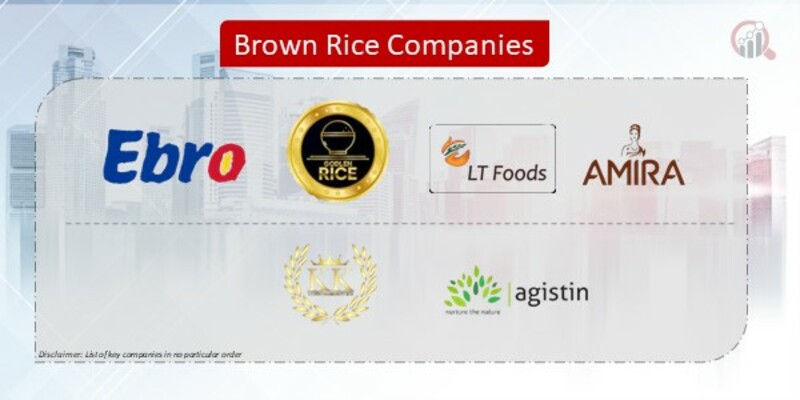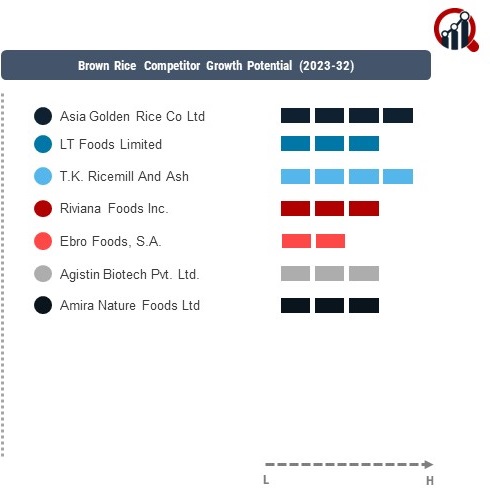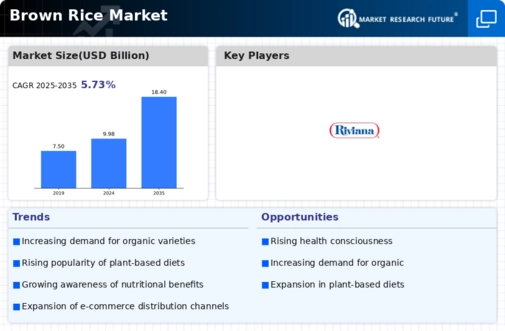Top Industry Leaders in the Brown Rice Market

Strategies Adopted by Brown Rice Key Players
The competitive landscape of the brown rice market is dynamic, influenced by evolving consumer preferences, technological advancements, and strategic movements by key players. This market encompasses various stakeholders, including rice cultivators, processors, distributors, and retailers, each contributing to the supply chain's efficiency and the product's marketability.
List of Key Players
- Asia Golden Rice Co Ltd (Thailand)
- LT Foods Limited (India)
- Amira Nature Foods Ltd (UAE)
- Rice Mill and Ash (Thailand)
- Ebro Foods, S.A. (Spain)
- Agistin Biotech Pvt. Ltd. (India)
- Riviana Foods Inc. (US)
Major players in the brown rice market have adopted various strategies to maintain and expand their market presence. These include product innovations, mergers and acquisitions, partnerships, and expansions into new geographic areas. Furthermore, companies are increasingly focusing on organic and non-GMO product lines, catering to rising health consciousness among consumers.
Market Share Analysis
Several factors influence the market share dynamics in the brown rice sector:
Product Quality and Variety: High-quality grains and a diverse product range attract more customers.
Brand Reputation and Trust: Established brands with a legacy of trust dominate over newer entrants.
Distribution Network: A robust and efficient distribution network ensures wider market reach.
Price Competitiveness: Competitive pricing can be crucial in price-sensitive markets.
Marketing and Promotions: Effective marketing strategies enhance brand visibility and consumer awareness.
New and Emerging Companies
The brown rice market is witnessing the entry of new players who are leveraging innovative technologies and marketing strategies to carve a niche. Startups are focusing on organic, sustainable farming practices and direct-to-consumer sales models to differentiate themselves.
Industry News and Current Company
Recently, there has been a significant focus on sustainable and environmentally friendly practices in the brown rice industry. Companies are increasingly adopting green technologies in processing and packaging. There's also a trend towards traceability and transparency in the supply chain, enabling consumers to track the origin and journey of their food products.
Investment Trends
The investment landscape in the brown rice market is evolving, with increased interest in sustainable and health-focused food products. Venture capitalists and private equity firms are showing keen interest in companies that are innovating in organic farming, supply chain efficiencies, and health-oriented products. Additionally, governments in several rice-producing countries are offering subsidies and support to farmers adopting sustainable practices, further stimulating investment in this sector.
Competitive Scenario
The brown rice market is moderately competitive, with a mix of well-established players and new entrants. The competition is based on factors such as price, quality, brand recognition, and distribution networks. AdditionallyThe rise in e-commerce has intensified competition, as online platforms provide a new avenue for brands to reach consumers directly.
Recent Development
The brown rice market has witnessed several significant developments:
Technological Advancements: Enhanced milling technologies that preserve more nutrients in brown rice have been a key focus area.
Expansion in Emerging Markets: Companies have been aggressively expanding in Asia, Africa, and South America, where there is a growing demand for healthier rice options.
Product Launches: There has been a spate of new product launches, focusing on enriched brown rice varieties with added health benefits.
Sustainability Initiatives: Major players have announced initiatives aimed at reducing the carbon footprint of rice production and promoting sustainable farming practices.
Strategic Partnerships: There have been strategic collaborations between key players and technology firms to enhance supply chain transparency and efficiency.
Regulatory Changes: New regulations and standards for quality and safety in several countries have prompted companies to adapt their production and processing methods.










